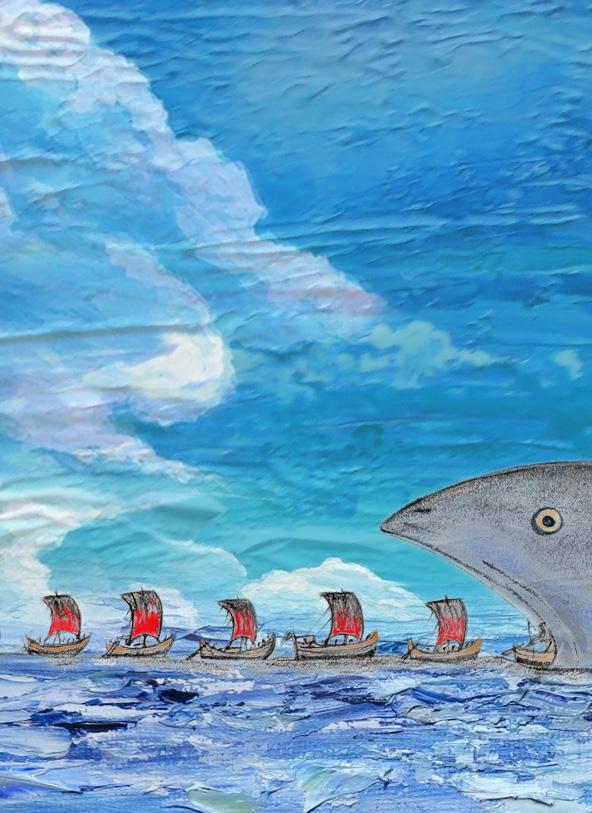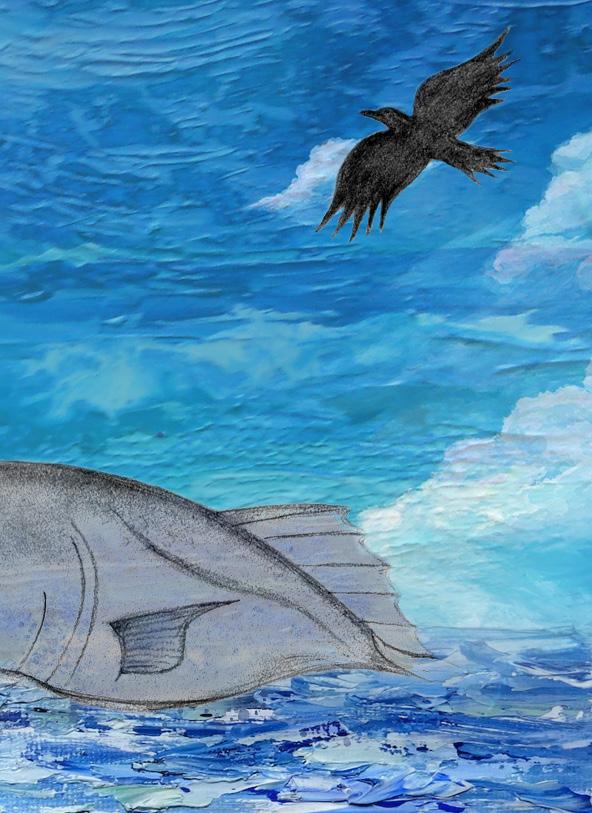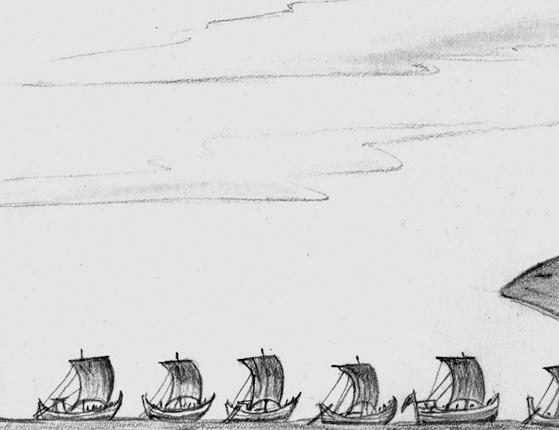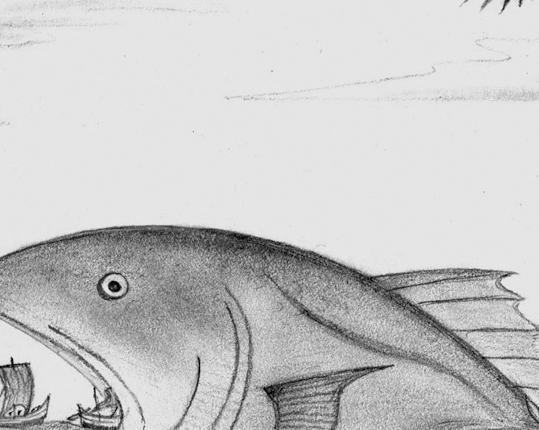
7 minute read
The Legend of Koimala
from RAYS Issue 3
By Xavier Romero Frías The legend of Koimala
Long ago, in the northern mainland, lived a poor couple in a hut deep in the forest. One day, the husband went to hunt and didn’t return. His wife, who was pregnant with her first child, went to look for her husband, dreading that something had happened to him. Whilst she was walking through the forest, the woman suddenly felt the pains of childbirth. She sat under a Nikabilissa (Asoka) tree and gave birth there alone. Whilst she was lying there exhausted, a tiger jumped out of a bush and devoured the woman. Since the child was hidden between two roots, the tiger didn’t see him and went away.
Advertisement

A herd of cows arrived after some time at that particular spot and one cow with a full udder happened to stand right above the child whilst she was grazing. The child felt for the nipple with his lips and sucked the milk. The cow, whose swollen udders had been hurting, felt relieved and returned everyday to that place under the Nikabilissa tree. In this manner the baby grew and, as soon as he could crawl, he followed the herd of cows.
Years passed and the child became a handsome boy, but he walked on all fours and said only “moo” like the cows. Hunters who spotted him in the jungle told the king about this wonder. His interest aroused, the monarch went out with his court into the forest where a trap was set. Shortly thereafter, the boy was caught in a net and was brought to the palace in a cage. The king invited all the learned men and doctors of his kingdom to see this amazing individual. All agreed that the child was not a monster, but a normal human being. Teachers were appointed for him and soon he learned how to talk and walk upright. The king remarked that he was an exceptionally handsome young man and gave him the name Maleffadakoi (the boy like a flower). Before long, the monarch discovered that he was full of wisdom and honesty, and came to trust him more than anyone else in his court.
One day the king asked Maleffadakoi, “During your life in the wilderness, what is the greatest wonder you saw?”
Then, the lad told the following story. “One day I was walking with the cows by the coast and I saw seven large ships sailing at a distance. Suddenly an enormous fish came out of the waters, opened its jaws and swallowed the seven vessels in one gulp. But before the fish could plunge back into the depths, a huge bird came from the sky and devoured the fish. However, the bird had flown but a short distance when an immense snake came out of a hole in a mountain and gulped down the bird.”

The king asked in amazement, “Would you be able to show me that mountain?” The boy agreed and the next few days were spent preparing for the journey, for it was in a very remote place.
After travelling a long distance, the king arrived at the mighty mountain along with Maleffadakoi and the royal retinue. They climbed to the summit and stared at the gaping hole in awe, fearing the snake would come out at any moment. The king ordered that large quantities of wood be thrown into the hole. During the next few days, thousands of the king’s slaves carried logs of wood dumping them day and night into the hole, but it was so deep that it took three whole months to fill it. Then the king ordered his slaves to set fire to the wood. The pit burned for 40 days and the whole mountain became so hot that it took as many days to cool.
Finally, one day they climbed the mountain and stood again close to the hole. The king looked down and ordered that a very long rope be brought. He first asked his warriors whether they dared to go into the pit. Since none of them had the courage, Maleffadakoi said he would go down himself. The boy went on a long descent, disappearing down into the depths of the mountain, whilst the king waited anxiously for him to come up. A long time passed and, as the monarch was resenting of having let his trusted friend climb down the hole, Maleffadakoi reappeared out of the darkness unscathed. He showed the king a fistful of gold dust he had kept in his robe and said, “I found it down there.”
The king realised that it was the purest gold he had ever seen and asked, “Is there a lot of it there?”
The boy answered that at the bottom of the pit there was nothing else but gold dust. However, he couldn’t tell how far down this went.
Then the king ordered his slaves to bring all this treasure to the surface and to transport it to his palace. After arduous work and a long journey back, the slaves stored so many basketfuls of gold dust that the palace vaults were overflowing with it.

The king was very pleased. His kingdom had never been so wealthy. Full of gratitude, he went to Maleffadakoi to tell him, “I owe my good fortune to you. Ask me any favour you want and I will grant it to you.”

The young man said, “O King, the only thing I want is a large ship with a crew of experienced sailors and a load of gold dust.” The kind monarch readily agreed, thinking it was a small price to pay for the blessings the boy had brought upon him and his kingdom. Once Maleffadakoi obtained his ship, he bade farewell to the king and sailed away from the coast, southwards into the Indian Ocean.
The ship entered the Maldives from the north at Ihavandu Island (Thiladummati Atoll) and anchored there at sunset. On the following day, a large white bird sat on top of the main mast. After squawking loudly, it flew southwards. This bird came again the next day and did the same thing. On the third day, Maleffadakoi told his sailors to follow the bird. Sailing southwards they finally entered North Male Atoll and arrived at an islet where the bird landed. This islet is called Dhoonidhoo (bird-island) today. Then it landed on a large sandbank close by. This sandbank was where the fishermen of
Giravaru, an island not far away to the west, used to cut and cook their fish. The sea surrounding the sandbank was always coloured red by the fish blood. Thus its name was Mahalē (Great Blood). There was no tree on Mahalē, but the bird was nowhere to be seen after it had landed there.
Maleffadakoi became friendly with the Giravaru people. They liked him and gave him the shorter name ‘Koimala’. They traded goods with him in exchange for gold dust. They also welcomed him to settle in Mahalē.
Koimala built the first house in Mahalē and also planted the first tree, which was a papaya tree. He also built a large warehouse to store his gold dust. After some time, people from all the atolls gathered in Mahalē and crowned Koimala king.
As the years went by, some wealthy traders settled in Mahalē, attracting other people until it became the most populous island. Eventually, the name of the island was shortened to Male and it became the capital of the island kingdom.
The islands then became Muslim and Koimala became a Muslim king. His name became ‘Darumavanta Rasgefānu’ (The Righteous King).
One day, on the street, coming out of the mosque after Friday Prayers, the king saw a child drawing a ship on the sand. The monarch thought it was very beautiful and asked the boy to sell him the ship. The boy said, “Majesty, I offer it to you.” Then the king went to the palace and ate lunch. After having finished his meal, whilst he was washing his hands, the child he had seen before came to him and said, “The ship is anchored in the harbour.”
The king went there and saw a large ship. The people onboard were all dressed in white. Then a small dinghy brought Koimala aboard the mysterious vessel. As soon as the king had set foot on it, the ship flew away and disappeared.







